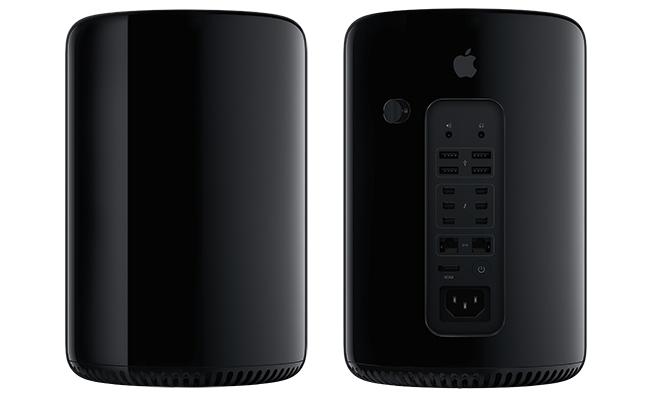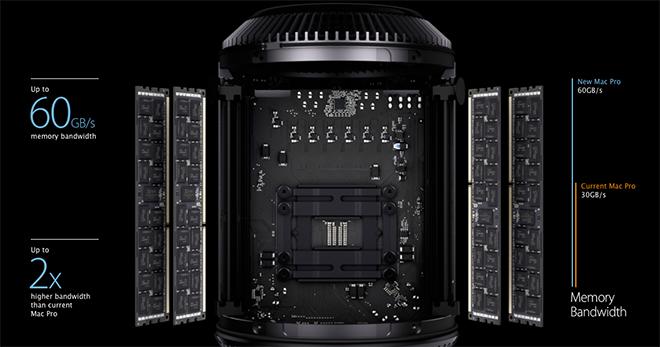Apple on Monday offered an uncharacteristic sneak peek of its forthcoming Mac Pro, which after years of being largely ignored has received a radical new design crammed with state-of-the-art hardware technology.
The most striking feature of the new Mac Pro is the cylindrical chassis wrapped in a black aluminum shell. Adding to the unique design is the size of the unit, which measures only 9.9-inches tall with a diameter of 6.6-inches.The new Mac Pro is one-eighth the volume of the outgoing tower style model.
Past the aesthetics lies a completely reimagined interior. All major components and boards in the Mac Pro are mounted to a triangular heat sink, which Apple is calling the "unified thermal core." According to the company, the use of the extruded aluminum structure was key in achieving such a compact design.
Heat is conducted away from the CPUs and GPUs and dispersed evenly across the surface of the thermal core. This allows for a single fan, situated at the top of the unit, to suck air up through an intake at the bottom of the computer, with exhaust flowing out vertically above the cylinder.
Screenshot of thermal core structure animation.As for silicon, Apple chose to stick with Intel's Xeon family of processors, though the next-generation Mac Pro will get next-generation E5 chipsets. Configurations will reportedly be capped at 12 cores, providing enough horsepower to double the floating-point performance of existing models. Along with the new Xeon boards comes support for PCI Express gen 3, which boasts bandwidth up to 40GBps, with 1.25GBps reads and 1.0GBps writes depending on the component loadout.
Mac Pro's configured SSD storage.In opting for a faster PCIe flash storage solution, which is clocked at 1250MB/s compared to SATA flash's 500MB/s and SATA HDD's 110MB/s, Apple has done away with the drive bays that made swapping HDDs so easy. The company may be hoping Thunderbolt 2-enabled external drives will pick up the slack, but some may be disappointed to see this useful feature go.
On the memory side, Apple is using four-channel ECC DDR3 modules running at 1866 MHz, which affords bandwidth up to 60GB/s. This also doubles the current Mac Pro's capabilities.
Graphics are handled by standard dual workstation-class AMD FirePro GPUs with up to 6GB of dedicated VRAM, which puts up to 70 teraflops of computing power on tap. Current Mac Pros perform at 2.7 teraflops.
Expansion has also been greatly enhanced, with a whopping six Thunderbolt 2 ports, four USB 3.0 ports, two Gigabit Ethernet ports, HDMI 1.4 and audio in/out. Thunderbolt 2 is the main draw here, with the protocol able to support 20Gbps throughput, up to six daisy-chained peripherals per port and backward compatibility with current Thunderbolt hardware. Intel, which developed the I/O standard, recently revealed the official specs of Thunderbolt 2 last week.
While the hardware specs are for the prototype Mac Pro, the production model is expected to be similar if not identical when it sees release this fall.
In previewing the professional-level computer, a rarity for Apple, it is assumed the company wanted to assuage concerns from some pro users who felt neglected after the company built multiple iMac and Mac mini refreshes without offering any major boost to the Mac Pro.
 AppleInsider Staff
AppleInsider Staff








-m.jpg)






 Brian Patterson
Brian Patterson
 Charles Martin
Charles Martin


 Malcolm Owen
Malcolm Owen
 William Gallagher
William Gallagher
 Christine McKee
Christine McKee
 Marko Zivkovic
Marko Zivkovic







1320 Comments
Details are wrong in several places about the ports. There are zero Firewire 800 ports, not two as stated in the article. There are four USB 3 ports; the article forgot to mention them. There are two Ethernet ports; the article is vague on this.
Details are wrong in several places about the ports. There are zero Firewire 800 ports, not two as stated in the article. There are four USB 3 ports; the article forgot to mention them. There are two Ethernet ports; the article is vague on this.
This is just such a futuristic marvel that has the potential to change the way Pros work.
Of course, most of them are retarded and unable to evolve, it's a shame they will be left behind. Same thing with keyboards and mouses, diskette and cd rom, you name it.
The level of stupid at Apple these days is overwhelming.
That has to be the worst possible design for a pro machine that I could imagine. Pros don't want cutesy cylinders, they want EXPANSION. Things like slots, lots of RAM slots, lots of PCI Express slots, and multiple hard drive bays, at least 4 of them. Pros still need optical drives. Pros want to be able to upgrade their graphics cards. Pros want multiple processors.
Think about what they could have done with this in the existing case: Dual 12 core processors. Up to 128GB RAM. 2 solid state drives AND 4 hard drives. And two Blu-Ray drives. And 4 PCI Express slots.
And the design is terrible too. This thing looks like a black aluminum can. Oh, wait, that's what it is.
There are zero Firewire 800 ports, not two as stated in the article.
There are two Ethernet ports; the article is vague on this.
The article's vague because its author thinks Ethernet is FireWire 800.
That has to be the worst possible design for a pro machine that I could imagine.
This proves that Apple has done 100% the right thing.
GUESS WHAT THE CYLINDER CAN DO, KIDDO.
That's so effing stupid.
Pros want a lot of cores. Multiple processors are just a means to that end. You'd know that if you actually knew anything.
Also? There are no single-chip processors with 12 cores from any manufacturer. Not that I can find, anyway. Not Sandy, Ivy, or Haswell.
Think about what they could have done with this in the existing case:
Yeah, they could have made it a worthless update that didn't actually innovate anything and for which they would have been mocked and derided because it was "late".
Instead they punched people like you in the metaphorical face and told you to shut up. This is the future. Deal with it.